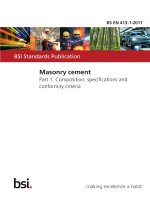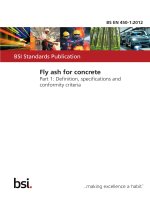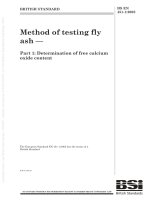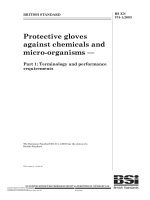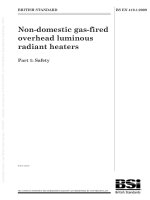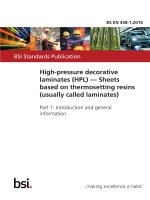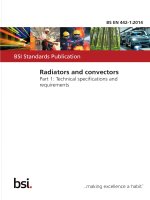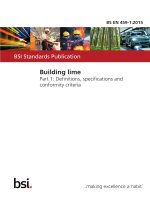Bsi bs en 62007 1 2015
Bạn đang xem bản rút gọn của tài liệu. Xem và tải ngay bản đầy đủ của tài liệu tại đây (2.15 MB, 40 trang )
BS EN 62007-1:2015
BSI Standards Publication
Semiconductor optoelectronic
devices for fibre optic system
applications
Part 1: Specification template for essential
ratings and characteristics
BRITISH STANDARD
BS EN 62007-1:2015
National foreword
This British Standard is the UK implementation of EN 62007-1:2015. It is
identical to IEC 62007-1:2015. It supersedes BS EN 62007-1:2009 which is
withdrawn.
The UK participation in its preparation was entrusted by Technical
Committee GEL/86, Fibre optics, to Subcommittee GEL/86/3, Fibre optic
systems and active devices.
A list of organizations represented on this committee can be obtained on
request to its secretary.
This publication does not purport to include all the necessary provisions of
a contract. Users are responsible for its correct application.
© The British Standards Institution 2015.
Published by BSI Standards Limited 2015
ISBN 978 0 580 81906 3
ICS 31.080.01; 31.260; 33.180.01
Compliance with a British Standard cannot confer immunity from
legal obligations.
This British Standard was published under the authority of the
Standards Policy and Strategy Committee on 31 July 2015.
Amendments/corrigenda issued since publication
Date
Text affected
BS EN 62007-1:2015
EUROPEAN STANDARD
EN 62007-1
NORME EUROPÉENNE
EUROPÄISCHE NORM
June 2015
ICS 31.080.01; 31.260; 33.180.01
Supersedes EN 62007-1:2009
English Version
Semiconductor optoelectronic devices for fibre optic system
applications - Part 1: Specification template for essential ratings
and characteristics
(IEC 62007-1:2015)
Dispositifs optoélectroniques à semiconducteurs pour
application dans les systèmes à fibres optiques - Partie 1:
Modèle de spécification relatif aux valeurs et
caractéristiques essentielles
(IEC 62007-1:2015)
Optoelektronische Halbleiterbauelemente für Anwendungen
in Lichtwellenleitersystemen - Teil 1: Vorlage für
Leistungsspezifikationen für wesentliche Grenz- und
Kennwerte
(IEC 62007-1:2015)
This European Standard was approved by CENELEC on 2015-05-04. CENELEC members are bound to comply with the CEN/CENELEC
Internal Regulations which stipulate the conditions for giving this European Standard the status of a national standard without any alteration.
Up-to-date lists and bibliographical references concerning such national standards may be obtained on application to the CEN-CENELEC
Management Centre or to any CENELEC member.
This European Standard exists in three official versions (English, French, German). A version in any other language made by translation
under the responsibility of a CENELEC member into its own language and notified to the CEN-CENELEC Management Centre has the
same status as the official versions.
CENELEC members are the national electrotechnical committees of Austria, Belgium, Bulgaria, Croatia, Cyprus, the Czech Republic,
Denmark, Estonia, Finland, Former Yugoslav Republic of Macedonia, France, Germany, Greece, Hungary, Iceland, Ireland, Italy, Latvia,
Lithuania, Luxembourg, Malta, the Netherlands, Norway, Poland, Portugal, Romania, Slovakia, Slovenia, Spain, Sweden, Switzerland,
Turkey and the United Kingdom.
European Committee for Electrotechnical Standardization
Comité Européen de Normalisation Electrotechnique
Europäisches Komitee für Elektrotechnische Normung
CEN-CENELEC Management Centre: Avenue Marnix 17, B-1000 Brussels
© 2015 CENELEC All rights of exploitation in any form and by any means reserved worldwide for CENELEC Members.
Ref. No. EN 62007-1:2015 E
BS EN 62007-1:2015
EN 62007-1:2015
Foreword
The text of document 86C/1256/CDV, future edition 3 of IEC 62007-1, prepared by SC 86C "Fibre
optic systems and active devices" of IEC/TC 86 "Fibre optics" was submitted to the IEC-CENELEC
parallel vote and approved by CENELEC as EN 62007-1:2015.
The following dates are fixed:
•
latest date by which the document has to be
implemented at national level by
publication of an identical national
standard or by endorsement
(dop)
2016-02-04
•
latest date by which the national
standards conflicting with the
document have to be withdrawn
(dow)
2018-05-04
This document supersedes EN 62007-1:2009.
EN 62007-1:2015 includes
EN 62007-1:2009:
the
following
significant
technical
changes
with
respect
to
1) The definitions of some symbols and terms are revised in order to harmonize them with those in
other SR 86C documents;
2) A clause on APD-TIA has been added.
Attention is drawn to the possibility that some of the elements of this document may be the subject of
patent rights. CENELEC [and/or CEN] shall not be held responsible for identifying any or all such
patent rights.
Endorsement notice
The text of the International Standard IEC 62007-1:2015 was approved by CENELEC as a European
Standard without any modification.
2
BS EN 62007-1:2015
EN 62007-1:2015
Annex ZA
(normative)
Normative references to international publications
with their corresponding European publications
The following documents, in whole or in part, are normatively referenced in this document and are
indispensable for its application. For dated references, only the edition cited applies. For undated
references, the latest edition of the referenced document (including any amendments) applies.
NOTE 1 When an International Publication has been modified by common modifications, indicated by (mod), the relevant
EN/HD applies.
NOTE 2 Up-to-date information on the latest versions of the European Standards listed in this annex is available here:
www.cenelec.eu
Publication
Year
Title
EN/HD
Year
IEC 60825
Series
Safety of laser products
EN 60825
Series
IEC 60747-5-1
-
Discrete semiconductor devices and
EN 60747-5-1
integrated circuits Part 5-1: Optoelectronic devices - General
-
3
BS EN 62007-1:2015
–2–
IEC 62007-1:2015 IEC 2015
CONTENTS
FOREWORD ......................................................................................................................... 5
1
Scope ............................................................................................................................ 7
2
Normative references..................................................................................................... 7
3
Terms, definitions and abbreviations .............................................................................. 7
3.1
Terms and definitions ............................................................................................ 7
3.2
Abbreviations ........................................................................................................ 9
4
LEDs for fibre optic systems or subsystems.................................................................... 9
4.1
4.2
4.3
4.4
Type ..................................................................................................................... 9
Semiconductor materials ....................................................................................... 9
Details of outline and encapsulation ...................................................................... 9
Limiting values (absolute maximum ratings) over the operating temperature
range, unless otherwise stated ............................................................................ 10
4.5
Electrical and optical characteristics .................................................................... 10
4.6
Supplementary information .................................................................................. 11
5
Laser module with pigtails ............................................................................................ 12
5.1
5.2
5.2.1
5.2.2
5.3
5.4
Type ................................................................................................................... 12
Semiconductor .................................................................................................... 12
Materials ...................................................................................................... 12
Structure ...................................................................................................... 12
Details of outline and encapsulation .................................................................... 12
Limiting values (absolute maximum ratings) over the operating temperature
range, unless otherwise stated ............................................................................ 13
5.4.1
General conditions ....................................................................................... 13
5.4.2
Laser diode .................................................................................................. 13
5.4.3
Photodiode .................................................................................................. 13
5.4.4
Thermal sensor (where appropriate) ............................................................. 13
5.4.5
Thermoelectric cooler (where appropriate) .................................................... 14
5.5
Electric and optical characteristics ....................................................................... 14
5.6
Supplementary information .................................................................................. 15
5.7
Hazards .............................................................................................................. 16
6
PIN photodiodes for fibre optic systems or subsystems ................................................. 16
6.1
6.2
6.3
6.4
Type ................................................................................................................... 16
Semiconductor materials ..................................................................................... 16
Details of outline and encapsulation .................................................................... 16
Limiting values (absolute maximum ratings) over the operating temperature
range, unless otherwise stated ............................................................................ 17
6.5
Electrical and optical characteristics .................................................................... 18
6.6
Supplementary information .................................................................................. 18
7
Avalanche photodiodes (APDs) with or without pigtails ................................................. 19
7.1
7.2
7.3
7.4
Type ................................................................................................................... 19
Semiconductor .................................................................................................... 19
Details of outline and encapsulation .................................................................... 19
Limiting values (absolute maximum ratings) over the operating temperature
range, unless otherwise stated ............................................................................ 19
7.5
Electrical and optical characteristics .................................................................... 19
7.6
Supplementary information .................................................................................. 20
8
PIN-TIA modules for fibre optic systems or subsystems ................................................ 21
BS EN 62007-1:2015
IEC 62007-1:2015 IEC 2015
–3–
8.1
8.2
8.3
8.4
8.5
Type ................................................................................................................... 21
Semiconductor materials ..................................................................................... 21
Structure ............................................................................................................. 21
Details of outline and encapsulation .................................................................... 21
Limiting values (absolute maximum ratings) over the operating temperature
range, unless otherwise stated ............................................................................ 22
8.6
Operating conditions at T amb = 25 °C, unless otherwise stated ........................... 22
8.7
Electrical and optical characteristics .................................................................... 23
8.8
Supplementary information .................................................................................. 23
9
APD-TIA modules for fibre optic systems or subsystems ............................................... 24
9.1
9.2
9.3
9.4
9.5
Type ................................................................................................................... 24
Semiconductor materials ..................................................................................... 24
Structure ............................................................................................................. 24
Details of outline and encapsulation .................................................................... 24
Limiting values (absolute maximum ratings) over the operating temperature
range, unless otherwise stated ............................................................................ 24
9.6
Electrical and optical characteristics .................................................................... 25
10 Laser diode modules for pumping an optical fibre amplifier ........................................... 26
10.1
10.2
10.3
10.4
10.5
Type ................................................................................................................... 26
Semiconductor materials ..................................................................................... 26
Structure ............................................................................................................. 26
Details of outline and encapsulation .................................................................... 26
Limiting values (absolute maximum ratings) over the operating temperature
range, unless otherwise stated ............................................................................ 27
10.6 Electrical and optical characteristics .................................................................... 27
10.7 Supplementary information .................................................................................. 29
10.8 Hazards .............................................................................................................. 29
11 Optical modulators for digital fibre optic applications .................................................... 29
11.1 Type ................................................................................................................... 29
11.2 Materials ............................................................................................................. 29
11.3 Structure ............................................................................................................. 29
11.4 Details of outline and encapsulation .................................................................... 30
11.5 Limiting values (absolute maximum ratings) ......................................................... 30
11.6 Electrical and optical characteristics .................................................................... 31
11.7 Supplementary information .................................................................................. 32
11.8 Hazards .............................................................................................................. 32
Bibliography ....................................................................................................................... 33
Table 1 – Limiting values for LEDs ...................................................................................... 10
Table 2 – Electrical and optical characteristics for LEDs ...................................................... 11
Table 3 – Electric and optical characteristics for laser modules with pigtails ......................... 14
Table 4 – Limiting values for PIN photodiodes ..................................................................... 17
Table 5 – Electrical and optical characteristics for PIN photodiodes ..................................... 18
Table 6 – Electrical and optical characteristics for avalanche photodiodes (APDs) with
or without pigtails ................................................................................................................ 20
Table 7 – Limiting values for PIN-TIA modules .................................................................... 22
Table 8 – Operating conditions for PIN-TIA modules ............................................................ 22
Table 9 – Electrical and optical characteristics for PIN-TIA modules ..................................... 23
BS EN 62007-1:2015
–4–
IEC 62007-1:2015 IEC 2015
Table 10 – Limiting values for APD-TIA modules ................................................................. 25
Table 11 – Electrical and optical characteristics for APD-TIA modules ................................. 25
Table 12 – Limiting values for laser diode modules for pumping an optical fibre
amplifier ............................................................................................................................. 27
Table 13 – Electrical and optical characteristics for laser diode modules for pumping
an optical fibre amplifier ...................................................................................................... 28
Table 14 – Limiting values for optical modulators for digital fibre optic applications .............. 30
Table 15 – Electrical and optical characteristics for optical modulators for digital fibre
optic applications ................................................................................................................ 31
BS EN 62007-1:2015
IEC 62007-1:2015 IEC 2015
–5–
COMMISSION ÉLECTROTECHNIQUE INTERNATIONALE
____________
SEMICONDUCTOR OPTOELECTRONIC DEVICES
FOR FIBRE OPTIC SYSTEM APPLICATIONS –
Part 1: Specification template for essential ratings and characteristics
FOREWORD
1) The International Electrotechnical Commission (IEC) is a worldwide organization for standardization comprising
all national electrotechnical committees (IEC National Committees). The object of IEC is to promote
international co-operation on all questions concerning standardization in the electrical and electronic fields. To
this end and in addition to other activities, IEC publishes International Standards, Technical Specifications,
Technical Reports, Publicly Available Specifications (PAS) and Guides (hereafter referred to as “IEC
Publication(s)”). Their preparation is entrusted to technical committees; any IEC National Committee interested
in the subject dealt with may participate in this preparatory work. International, governmental and nongovernmental organizations liaising with the IEC also participate in this preparation. IEC collaborates closely
with the International Organization for Standardization (ISO) in accordance with conditions determined by
agreement between the two organizations.
2) The formal decisions or agreements of IEC on technical matters express, as nearly as possible, an international
consensus of opinion on the relevant subjects since each technical committee has representation from all
interested IEC National Committees.
3) IEC Publications have the form of recommendations for international use and are accepted by IEC National
Committees in that sense. While all reasonable efforts are made to ensure that the technical content of IEC
Publications is accurate, IEC cannot be held responsible for the way in which they are used or for any
misinterpretation by any end user.
4) In order to promote international uniformity, IEC National Committees undertake to apply IEC Publications
transparently to the maximum extent possible in their national and regional publications. Any divergence
between any IEC Publication and the corresponding national or regional publication shall be clearly indicated in
the latter.
5) IEC itself does not provide any attestation of conformity. Independent certification bodies provide conformity
assessment services and, in some areas, access to IEC marks of conformity. IEC is not responsible for any
services carried out by independent certification bodies.
6) All users should ensure that they have the latest edition of this publication.
7) No liability shall attach to IEC or its directors, employees, servants or agents including individual experts and
members of its technical committees and IEC National Committees for any personal injury, property damage or
other damage of any nature whatsoever, whether direct or indirect, or for costs (including legal fees) and
expenses arising out of the publication, use of, or reliance upon, this IEC Publication or any other IEC
Publications.
8) Attention is drawn to the Normative references cited in this publication. Use of the referenced publications is
indispensable for the correct application of this publication.
9) Attention is drawn to the possibility that some of the elements of this IEC Publication may be the subject of
patent rights. IEC shall not be held responsible for identifying any or all such patent rights.
International Standard IEC 62007-1 has been prepared by subcommittee 86C: Fibre optic
systems and active devices, of IEC technical committee 86: Fibre optics.
This third edition cancels and replaces the second edition published in 2008. This edition
constitutes a technical revision.
This edition includes the following significant technical changes with respect to the previous
edition.
1) The definitions of some symbols and terms are revised in order to harmonize them with
those in other SC 86C documents.
2) A clause on APD-TIA has been added.
BS EN 62007-1:2015
–6–
IEC 62007-1:2015 IEC 2015
The text of this standard is based on the following documents:
CDV
Report on voting
86C/1256/CDV
86C/1283/RVC
Full information on the voting for the approval of this standard can be found in the report on
voting indicated in the above table.
This publication has been drafted in accordance with the ISO/IEC Directives, Part 2.
A list of all parts in the IEC 62007 series, published under the general title Semiconductor
optoelectronic devices for fibre optic system applications, can be found on the IEC website.
The committee has decided that the contents of this publication will remain unchanged until
the stability date indicated on the IEC web site under "" in the data
related to the specific publication. At this date, the publication will be
•
•
•
•
reconfirmed,
withdrawn,
replaced by a revised edition, or
amended.
BS EN 62007-1:2015
IEC 62007-1:2015 IEC 2015
–7–
SEMICONDUCTOR OPTOELECTRONIC DEVICES
FOR FIBRE OPTIC SYSTEM APPLICATIONS –
Part 1: Specification template for essential ratings and characteristics
1
Scope
This part of IEC 62007 is a specification template for essential ratings and characteristics of
the following categories of semiconductor optoelectronic devices to be used in the field of
fibre optic systems and subsystems:
–
semiconductor photoemitters;
–
semiconductor photoelectric detectors;
–
monolithic or hybrid integrated optoelectronic devices and their modules.
This part of IEC 62007 provides a frame for the preparation of detail specifications for the
essential ratings and characteristics.
In using this part of IEC 62007, detail specification writers add but do not delete specification
parameters and/or groups of specification parameters for particular applications.
2
Normative references
The following documents, in whole or in part, are normatively referenced in this document and
are indispensable for its application. For dated references, only the edition cited applies. For
undated references, the latest edition of the referenced document (including any
amendments) applies.
IEC 60825 (all parts), Safety of laser products
IEC 60747-5-1, Discrete semiconductor
Optoelectronic devices – General
3
3.1
devices
and
integrated
circuits
–
Part
5-1:
Terms, definitions and abbreviations
Terms and definitions
For the purposes of this document, the terms and definitions concerning physical concepts,
types of devices, general terms, and ratings and characteristics given in IEC 60747-5-1 and
the following apply.
3.1.1
PIN photodiode
photodiode with a large intrinsic region sandwiched between P- and N-doped semiconducting
regions used for the detection of optical radiation
[SOURCE:
IEC 60050-731-06-29, modified — The note has been deleted.]
BS EN 62007-1:2015
–8–
IEC 62007-1:2015 IEC 2015
3.1.2
avalanche photodiode
APD
photodiode operating with a bias voltage such that the primary photocurrent undergoes
amplification by cumulative multiplication of charge carriers
Note 1 to entry:
[SOURCE:
This note applies to the French language only.
IEC 60050-731-06-30, modified — The note has been deleted.]
3.1.3
RIN
relative intensity noise
quotient of the radiant power mean square fluctuations < ∆Φ e2 > to the mean square radiant
power < Φ e > 2 , normalized to a frequency band of unit width
Note 1 to entry:
RIN is usually expressed in dB/Hz.
{
2
(
2
RIN = 10 log10 < ∆Φ e > < Φ e > × ∆f
Note 2 to entry:
)}
This note applies to the French language only.
3.1.4
∆λc
spectral shift
deviation of the peak-emission wavelength at a particular case temperature or a particular
forward current from its value at a specified reference case temperature or a specified
reference forward current, respectively
Note 1 to entry:
The specific reference temperature is typically 25 °C.
3.1.5
s 11
input reflection coefficient
quotient of the high frequency reflected voltage to the high frequency incident voltage
3.1.6
E tr
tracking error
deviation of the radiant power at a particular case temperature from its value at a specified
reference case temperature
Note 1 to entry:
The specific reference temperature is typically 25 °C.
Note 2 to entry: Specifications usually refer to the maximum deviation (absolute value) in two specified
temperature ranges below and above the specified reference case temperature.
Note 3 to entry: The tracking error is usually expressed as a percentage of the radiant power at the reference
case temperature.
3.1.7
RD
R
diode responsivity
responsivity
photodiode
Note 1 to entry:
If no ambiguity is likely to occur, the shorter term and shorter letter symbol may be used.
BS EN 62007-1:2015
IEC 62007-1:2015 IEC 2015
Note 2 to entry:
–9–
Photodiode means a complete device such as:
–
chip itself;
–
packaged component with window or pigtail.
3.1.8
Fe
excess noise factor
noise resulting from the spatial and timing fluctuations of the avalanche carrier multiplication,
defined as the ratio of the noise power at a specified reverse bias to the amplified shot noise
of the photocurrent at a reference reverse bias
Note 1 to entry: The reference reverse voltage should be sufficiently low that no carrier multiplication takes place
but sufficiently large that the device is fully depleted and has achieved its rated speed and responsivity.
3.1.9
Po
overload
maximum received power of a photodiode for obtaining a given bit error rate
3.2
Abbreviations
APD
avalanche photodiode
BH
buried heterostructure
CMOS
complementary metal-oxide semiconductor
CW
continuous wave
FWHM
full width at half maximum
HBT
heterojunction bipolar transistor
LD
laser diode
LED
light emitting diode
MQW
multi-quantum well
RIN
relative intensity noise
TEC
thermo-electric cooler
TIA
transimpedance amplifier
4
LEDs for fibre optic systems or subsystems
4.1
Type
Ambient-rated or case-rated LED with or without optical fibre pigtail for fibre optic systems or
subsystems
4.2
Semiconductor materials
GaAs, GaAlAs, InGaAs, InP, etc.
4.3
Details of outline and encapsulation
4.3.1
IEC and/or national reference number of outline drawing
4.3.2
Method of encapsulation: glass/metal/plastic/other
4.3.3
Terminal identification and indication of any electrical connection between a terminal
and the case
BS EN 62007-1:2015
– 10 –
IEC 62007-1:2015 IEC 2015
4.3.4
Characteristics of the optical port: relative orientation to mechanical axis, relative
position to mechanical axis, area, numerical aperture
4.3.5
For devices with a fibre pigtail: information on the pigtail fibre, kind of protection,
connector, length
4.3.6
4.4
Information on the heat sink of the package
Limiting values (absolute maximum ratings) over the operating temperature range,
unless otherwise stated
See Table 1.
Table 1 – Limiting values for LEDs
Characteristics
Symbol
Requirements a
Unit
Min.
Max.
T stg
x
x
°C
either ambient temperature
T amb
x
x
°C
or case temperature
T case
x
x
°C
Storage temperature
Temperature:
Soldering temperature at maximum soldering time and
minimum distance to case specified
T sld
x
°C
Reverse voltage
VR
x
V
Continuous forward current
Derating curve or derating factor
IF
x
mA
Repetitive peak forward current at specified pulse conditions
(where appropriate)
Derating curve or derating factor (where appropriate)
I FRM
x
mA
Power dissipation
Derating curve or derating factor (where appropriate)
P tot
x
W
T vj
x
°C
For case-rated devices:
Virtual junction temperature (where appropriate)
For devices with pigtail:
Bend radius of pigtail (at specified distance from the case)
r
x
mm(cm)
Shock
x
m/s 2 , s
Vibration
x
m/s 2 , Hz
Tensile force on devices with pigtail:
Untight structure:
– Tensile force on fibre along its axis
– Tensile force on cladding along its axis
F
F
x
x
N
N
Tight structure:
– Tensile force on pigtail along its axis
F
x
N
a
4.5
x represents the value to be specified.
Electrical and optical characteristics
See Table 2.
BS EN 62007-1:2015
IEC 62007-1:2015 IEC 2015
– 11 –
Table 2 – Electrical and optical characteristics for LEDs
Characteristics
Conditions at
T amb or T case = 25 °C
unless otherwise stated
Symbol
Requirements b
Min.
Max.
Unit
Forward voltage
I F or Φ e specified
VF
x
V
Reverse current
V R specified
IR
x
mA
Differential resistance
I F or Φ e specified
rd
x
Ω
Total capacitance
V R , f specified
C tot
x
µF
I F or Φ e , f o , ∆f N specified
RIN
x
dB/Hz
I F or Φ e , f c , ∆f N , f m , m
specified
C/N
x
dB
either radiant output power
I F specified (d.c. or pulse, or
both)
Φe
x
xa
mW
or forward current
Φ e specified
IF
xa
x
mA
For devices without pigtail:
Half-intensity angle a
I F or Φ e , angle φ specified
θ 1/2
x
°
For devices without pigtail:
Misalignment angle a
I F or Φ e , angle φ specified
∆θ
x
°
Spectral radiation bandwidth
I F or Φ e specified
∆λ
x
nm
Noise parameter
either relative intensity noise a
or carrier-to-noise
ratio a
Output parameter
Bandwidth
either switching times:
– rise time
– fall time
d.c. current
x
s
input pulse current
tr
x
s
pulse width and duty cycle
specified
tf
x
s
t d(on) ,
t d(off)
x
s
– delay times a
– peak emission wavelengths
or cut-off frequency
a
Where appropriate.
b
x represents the value to be specified.
4.6
4.6.1
nm
I F or Φ e specified
fc
x
Hz
Supplementary information
Typical curve or coefficient
Provide the curve or coefficient in 4.6.1.1 or 4.6.1.2.
4.6.1.1
Typical curve or coefficient of radiant power versus temperature and typical curve
of radiant output power versus forward current (d.c. or pulse, as specified)
4.6.1.2
Typical curve or coefficient of radiant intensity versus temperature and typical
curve of radiant intensity versus forward current (d.c. or pulse, as specified)
4.6.2
Typical curve or coefficient of change in peak emission wavelength versus temperature
4.6.3
Typical radiation diagram
4.6.4
Thermal resistance, ambient-rated or case-rated
BS EN 62007-1:2015
– 12 –
5
IEC 62007-1:2015 IEC 2015
Laser module with pigtails
5.1
Type
The laser module consists of the following basic parts:
–
laser diode
–
pigtail
–
photodiodes
–
thermal sensor
–
TEC element
5.2
where appropriate
Semiconductor
5.2.1
Materials
The laser module consists of the following materials:
–
laser diode (e.g. GaAs, GaAlAs, InGaAsP, InP)
–
photodiode (e.g. Ge, Si, GaInAs)
–
thermal sensor
–
TEC element
5.2.2
where appropriate
Structure
Laser diode, e.g. gain guided, index guided, distributed feedback
5.3
Details of outline and encapsulation
5.3.1
IEC and/or national reference number of the outline drawing
5.3.2
Method of encapsulation: glass/metal/plastic/other
5.3.3
Terminal identification and indication of any electrical connection between a terminal
and the case
5.3.4
Information on the pigtail fibre, e.g. type of fibre, kind of protection, connector, length
5.3.5
Information on the heatsinking of the package
BS EN 62007-1:2015
IEC 62007-1:2015 IEC 2015
5.4
– 13 –
Limiting values (absolute maximum ratings) over the operating temperature range,
unless otherwise stated
5.4.1
General conditions
5.4.1.1
Minimum and maximum storage temperatures (T stg )
5.4.1.2
Minimum and maximum operating case temperatures (T case )
5.4.1.3
Minimum and maximum operating submount temperature (T sub )
5.4.1.4
(T sld )
Maximum soldering temperature (soldering time and minimum distance to case)
5.4.1.5
Minimum bend radius of pigtail (at specified distance from the case) (r)
5.4.1.6
Shock (maximum acceleration and pulse duration)
5.4.1.7
Vibration (maximum acceleration and frequency range)
5.4.1.8
Tensile force along cable axis
5.4.1.8.1
Untight structure
–
Maximum tensile force on fibre (F)
–
Maximum tensile force on cable (F)
5.4.1.8.2
–
Tight structure
Maximum tensile force on cable (F)
5.4.2
Laser diode
For laser module without TEC, derating curve or derating factor shall be given for one of the
parameters 5.4.2.2 to 5.4.2.5. For laser module with TEC, T sub = 25 °C.
5.4.2.1
Maximum reverse voltage (V R )
5.4.2.2
Maximum continuous forward current (I F )
5.4.2.3
Maximum continuous radiant power (ϕ e )
5.4.2.4
Maximum pulsed forward current at stated frequency and pulse duration (I FP )
5.4.2.5
Maximum pulsed radiant power at stated frequency and pulse duration (ϕ ep )
5.4.3
Photodiode
5.4.3.1
Maximum reverse voltage (V R )
5.4.3.2
Maximum forward current (I F )
5.4.4
5.4.4.1
5.4.4.1.1
Thermal sensor (where appropriate)
Maximum ratings
Maximum power dissipation (P)
or
5.4.4.1.2
Maximum voltage supply (V)
BS EN 62007-1:2015
– 14 –
5.4.5
Thermoelectric cooler (where appropriate)
5.4.5.1
5.5
IEC 62007-1:2015 IEC 2015
Maximum cooler current under cooling and heating (I PE )
Electric and optical characteristics
See Table 3.
Table 3 – Electric and optical characteristics for laser modules with pigtails
Characteristics
Conditions at T sub = 25 °C for
laser with TEC, T amb or
T case = 25 °C for laser module
without TEC unless otherwise
stated
Requirements c
Unit
Symbol
Min.
Max.
A. Laser diode
Forward voltage
I F or Φ e specified
VF
x
V
x
mA
φe(TH)
x
µW
x
mA
I (TH)
Threshold current
x
Radiant power at threshold
I F = I TH
Forward current above threshold (for
laser module without TEC)
Φ e specified
T = T case max. or T amb max.
∆I F
Differential efficacy (for laser module
without TEC)
Φ e or ∆I F specified
T = T case max. or T amb max.
ηd
x
x
Peak emission wavelength
Φ e or ∆I F specified
CW-operation
λpa
x
x
nm
Either spectral radiation bandwidth
FWHM
Φ e or ∆I F specified
CW-operation
λpa
x
nm
or mode spacing and number of
longitudinal modes
Φ e or ∆I F specified CW-operation
ηm
x
Peak emission wavelength under
modulation
Φ e or ∆I F specified
modulation condition specified
λpb
Spectral radiation bandwidth under
modulation
Φ e or ∆I F specified
modulation condition specified
λpb
Spectral characteristics
x
x
nm
x
Additional spectral characteristics
and/or centroidal wavelength
Φ e or ∆I F specified CW-operation
λ avg a
and/or spectral radiation r.m.s.
bandwidth
Φ e or ∆I F specified
∆ λ rms
or mode spacing and number of
longitudinal modes
Φ e or ∆I F specified
ηm
or central wavelength under
modulation
Φ e or ∆I F specified
modulation condition specified
λb
or spectral radiation r.m.s. bandwidth
under modulation
Φ e or ∆I F specified
modulation condition specified
x
a
x
nm
x
nm
x
x
x
nm
∆ λ rms b
x
nm
x
nm
Single spectral mode laser module under specified direct modulation
Spectral mode width
Φ e or ∆I F specified
modulation condition specified
∆λL
Side-mode suppression ratio
Φ e or ∆I F specified
modulation condition specified
SMSR
x
dB
Spectral shift
Spectral shift for module with TEC
Spectral shift for laser module
without TEC
Transient parameters
∆I F1 , ∆I F2 , φe1 , φe2
a
a,
T amb or T case
T amb b or T case b
∆λc
x
nm
∆λc
x
nm
BS EN 62007-1:2015
IEC 62007-1:2015 IEC 2015
– 15 –
Conditions at T sub = 25 °C for
laser with TEC, T amb or
T case = 25 °C for laser module
without TEC unless otherwise
stated
Characteristics
Requirements c
Symbol
Unit
Min.
Max.
Bias current ∆I F or φe
input pulse current
width and duty cycle specified
tr,
tf
x
x
s
s
Turn-on time,
turn-off time
Bias current ∆I F or ϕ e
input pulse current
width and duty cycle specified
t on ,
t off
x
x
s
s
Cut-off frequency
Φ e or ∆I F specified
x
Hz
Carrier-to-noise ratio
Rise time,
fall time
and/or
fc
x
∆I F or Φ e , ∆f, f m , m and f 0 specified
C/N
x
Dark current
Φe = 0
I r(0)
Reverse current under optical
radiation
Φ e or ∆I F specified
V R specified
I R(e)
Either diode capacitance
V R and f specified
or
rise time,
fall time
Φ e or ∆I F specified
V R specified
dB
B. Monitor photodiode
V R specified
x
µA
x
µA
C tot
x
pF
tr,
tf
x
s
E R1
x
E R2
x
x
Diode capacitance or rise/fall time
Tracking error
Either
Φ e or ∆I F and V R specified,
Temperature range: 25 °C to
T case min. or T amb min.
or
Φ e or ∆I F and V R specified,
Temperature range: 25 °C to
T case min. or T amb min.
C. Thermistor (where appropriate)
Resistance
Thermistor current I tc specified
R
x
x
Slope of resistance
Thermistor current I tc specified.
Temperature range:
T sub a , T sub b
∆R/R
x
x
Ω
D. TEC current (where appropriate)
TEC current
Φ e or ∆I F specified,
Temperature range: T case min. or
T case max.
I PE
x
A
TEC voltage
Φ e or ∆I F specified,
Temperature range: T case or
T amb min. and max.
V PE
x
V
a
CW-operation.
b
In modulation.
c
x represents the value to be specified.
5.6
5.6.1
Supplementary information
DC forward current of the laser diode corresponding to ϕ eoo
NOTE ϕ eoo is the radiant power value of the laser chip on submount, representative of the performance and
reliability of devices manufactured using the same technology and submitted to the same quality assurance
procedures.
BS EN 62007-1:2015
– 16 –
IEC 62007-1:2015 IEC 2015
5.6.2
Response time of the thermistor temperature to the change of cooler current (where
appropriate)
5.6.3
Thermal resistance between laser diode junction and case (without cooler): R thj-c
5.6.4
s 11 parameter
5.7
Hazards
See IEC 60825.
6
PIN photodiodes for fibre optic systems or subsystems
6.1
Type
Ambient-rated or case-rated PIN photodiodes with or without optical fibre pigtail for fibre optic
systems or subsystems
6.2
Semiconductor materials
Si, Ge, InGaAs, etc.
6.3
Details of outline and encapsulation
6.3.1
IEC and/or national reference number of outline drawing
6.3.2
Method of encapsulation: glass/metal/plastic/other
6.3.3
Terminal identification and indication of any electrical connection between a terminal
and the case
6.3.4
Characteristics of the optical port: relative orientation to mechanical axis, relative
position to mechanical axis, area, numerical aperture
6.3.5
For devices with pigtail: information on the pigtail fibre, type of fibre, kind of
protection, connector, length
6.3.6
Information on the heat sink of the package
BS EN 62007-1:2015
IEC 62007-1:2015 IEC 2015
6.4
– 17 –
Limiting values (absolute maximum ratings) over the operating temperature range,
unless otherwise stated
See Table 4.
Table 4 – Limiting values for PIN photodiodes
Characteristics
Symbol
Requirements a
Unit
Min.
Max.
T stg
x
x
°C
either ambient temperature
T amb
x
x
°C
or case temperature
T case
x
x
°C
Storage temperature
Temperature
Soldering temperature at maximum soldering time and
minimum distance to case specified
T sld
x
°C
Reverse voltage
VR
x
V
Power dissipation
P tot
x
W
Radiant power on the sensitive area
Φe
x
W
For devices with pigtail:
Bend radius of pigtail (at specified distance from the case)
r
x
mm(cm)
Shock
x
m/s 2 , s
Vibration
x
m/s 2 , Hz
Tensile force on devices with pigtail:
Untight structure:
– Tensile force on fibre along its axis
F
x
N
– Tensile force on cladding along its axis
F
x
N
F
x
N
Tight structure:
– Tensile force on pigtail along its axis
a
x represents the value to be specified.
BS EN 62007-1:2015
– 18 –
6.5
IEC 62007-1:2015 IEC 2015
Electrical and optical characteristics
See Table 5.
Table 5 – Electrical and optical characteristics for PIN photodiodes
Characteristics
Conditions at
T amb or T case = 25 °C
unless otherwise stated
Symbol
Requirements c
Min.
Max.
Unit
Dark current
Dark current
Dark current at high temperature
V R specified, Φ e = 0
V R specified, Φ e = 0
T amb or T case specified
I R(D) a
x
µA
b
x
µA
Total capacitance
V R , f specified, Φ e = 0
C tot
x
pF
Noise current
V R , I R(e) , f 0 , ∆f N , R L , λ p , ∆ λ
specified
In
x
µA
xa
A/W
I R(D)
For devices without pigtail:
Sensitivity along the specified
mechanical axis
V R , λ p , ∆ λ , Φ e specified
Spatial uniformity of sensitivity
(where appropriate)
V R , λ p , ∆ λ or Φ e specified
For devices with pigtail:
Sensitivity
V R , λ p , ∆ λ , Φ e specified
S FD , S
x
x
∆S
S FD , S
x
xa
Bandwidth
either
Switching time:
– Rise time
– Fall time
– Delay times (where appropriate)
– Storage time
GHz
V R , λ p , ∆ λ , pulse base Φ e1 ,
pulse top Φ e2 , R L specified
tr
tf
t d(on) , t d(off)
ts
x
x
x
x
s
s
s
s
or
Cut-off frequency
NOTE
a
V R , λ p , ∆ λ , Φ e , R L specified
fc
x
The specified voltage V R is the same for all the characteristics, unless otherwise stated.
Where appropriate.
b
Term and/or letter symbol under consideration.
c
x represents the value to be specified.
6.6
Supplementary information
6.6.1
Typical curve of dark current versus voltage, at different temperatures
6.6.2
Typical curve of total capacitance versus reverse voltage
6.6.3
Relative sensitivity versus wavelength
6.6.4
Relative sensitivity versus temperature
6.6.5
Derating curve or derating factor of maximum dissipation
Hz
BS EN 62007-1:2015
IEC 62007-1:2015 IEC 2015
7
– 19 –
Avalanche photodiodes (APDs) with or without pigtails
7.1
Type
Ambient-rated or case-rated APD for fibre optic systems or subsystems
7.2
Semiconductor
7.2.1
Materials: Si, Ge, InGaAs, etc.
7.2.2
Structure
7.3
Details of outline and encapsulation
7.3.1
IEC and/or national reference number of outline drawing
7.3.2
Method of encapsulation: glass/metal/plastic/other
7.3.3
Terminal identification and indication of any electrical connection between a terminal
and the case
7.3.4
Characteristics of the optical port: relative orientation to the mechanical axis, relative
position to mechanical axis, area, numerical aperture
7.3.5
Information on the pigtail fibre (where appropriate): type of fibre, kind of protection,
connector, length
7.4
Limiting values (absolute maximum ratings) over the operating temperature range,
unless otherwise stated
7.4.1
Minimum bend radius of the pigtail, where appropriate
7.4.2
Minimum and maximum storage temperature (T stg )
7.4.3
Minimum and maximum operating ambient or case temperatures (T amb or T case )
7.4.4
Maximum soldering temperature (T sld ) (soldering time and minimum distance to case
to be specified)
7.4.5
Maximum power dissipation at ambient or case temperature of 25 °C (P tot ) and
derating curve or derating factor
7.4.6
Maximum pull force for pigtail (fibre or cable), where appropriate, in the direction of
the axis of the input pigtail (fibre or cable)
7.4.7
Maximum reverse current (I R )
7.4.8
Maximum forward current (I F )
7.5
Electrical and optical characteristics
V R shall be the same for all characteristics; it shall be equal to 0,9 times the individually
measured value of V (BR) , unless otherwise specified.
See Table 6.
BS EN 62007-1:2015
– 20 –
IEC 62007-1:2015 IEC 2015
Table 6 – Electrical and optical characteristics for avalanche
photodiodes (APDs) with or without pigtails
Conditions at
T amb or T case = 25 °C
unless otherwise stated
Characteristics
Symbol
Requirements c
Min.
Max.
x
x
Unit
E e or ϕ e = 0,
I R specified
V (BR)
Reverse dark current (NOTE 1)
E e or ϕ e = 0,
V R specified
IRa
x
µA
Reverse dark current (NOTE 2)
E e or ϕ e = 0,
V R specified
T = T amb max. or T case max.
IRb
x
µA
Sensitivity (NOTE 1)
V R1 (NOTE 2), ϕ e , λ pp , ∆ λ
specified
Sa
x
x
(NOTE 1)
A/W
Sensitivity (NOTE 2)
V R , ϕ e , λ p , ∆ λ specified
Sb
x
x
(NOTE 2)
A/W
Multiplication factor
V R1 (NOTE 2), λ p , ∆ λ , ϕ e
specified
M
x
Total capacitance
E e or ϕ e = 0; V R , f specified
C tot
x
pF
VR, ∆λ , RL ,
ϕ e1 : peak radiant power
ϕ e2 : offset radiant power
t on
t off
x
x
s
Breakdown voltage
Reverse dark current
Sensitivity
Small signal parameters
Turn-on time and turn-off time
Small signal cut-off frequency
V R , λ p , ∆ λ , ϕ e and R L
specified
fc
Excess noise factor
V R1 (NOTE 2), V R , I PO , λ p ,
∆ λ , M, f 0 ,
Fe
x
In
x
x
s
Hz
∆f N specified
Noise current a
NOTE 1
V R , λ p , ∆ λ , f, ∆f N specified
µA
Where appropriate.
NOTE 2 Typically, V R1 is a small value at which negligible carrier multiplication takes place, or the voltage at
which the device is fully depleted and has achieved its rated speed.
a
Where appropriate.
b
Term and/or letter symbol under consideration.
c
x represents the value to be specified.
7.6
Supplementary information
7.6.1
Curve of breakdown voltage versus temperature
7.6.2
Curve of sensitivity versus wavelength
7.6.3
Curve of capacitance versus reverse voltage
7.6.4
Curve of multiplication factor versus reverse voltage at different temperatures
7.6.5
Curve of reverse dark current versus reverse voltage at different temperatures
7.6.6
Location of sensitive area by reference to the package (without pigtail)
BS EN 62007-1:2015
IEC 62007-1:2015 IEC 2015
– 21 –
7.6.7
Curve of excess noise factor versus reverse voltage (where appropriate)
7.6.8
Curve of noise current versus reverse voltage (where appropriate)
8
8.1
PIN-TIA modules for fibre optic systems or subsystems
Type
Ambient-rated or case-rated PIN-TIA modules for fibre optic systems or subsystems
The PIN-TIA module consists of the following basic parts:
–
PIN photodiode;
–
TIA circuits;
–
fibre pigtail, pigtail connectors, receptacles (connectorized package).
8.2
Semiconductor materials
The PIN-TIA module consists of the following semiconductor materials:
–
PIN photodiode: Si, Ge, InGaAs, etc.;
–
TIA circuits: GaAs, Si, etc.
8.3
Structure
The structure of the PIN-TIA module is as follows:
–
PIN photodiode: Mesa, planar, etc.;
–
TIA circuits: CMOS, Bi-CMOS, HBT, Bi-polar etc.;
–
information on the fibre coupling: taper type, lens coupling, etc.;
–
information on the circuit: high impedance, transimpedance, bandwidth, etc.;
–
information on the package: pigtail, receptacle (connectorized package), etc.
8.4
Details of outline and encapsulation
–
IEC and/or national reference number of outline drawing
–
Method of encapsulation: glass/metal/plastic/other
–
Terminal identification and indication of any electrical connection between a terminal and
the case
–
Characteristics of the optical port: orientation relative to mechanical axis, position relative
to mechanical axis, area, numerical aperture
–
Information on the pigtail fibre: type of fibre, kind of protection, connector, length
–
Information on the connector/receptacle
